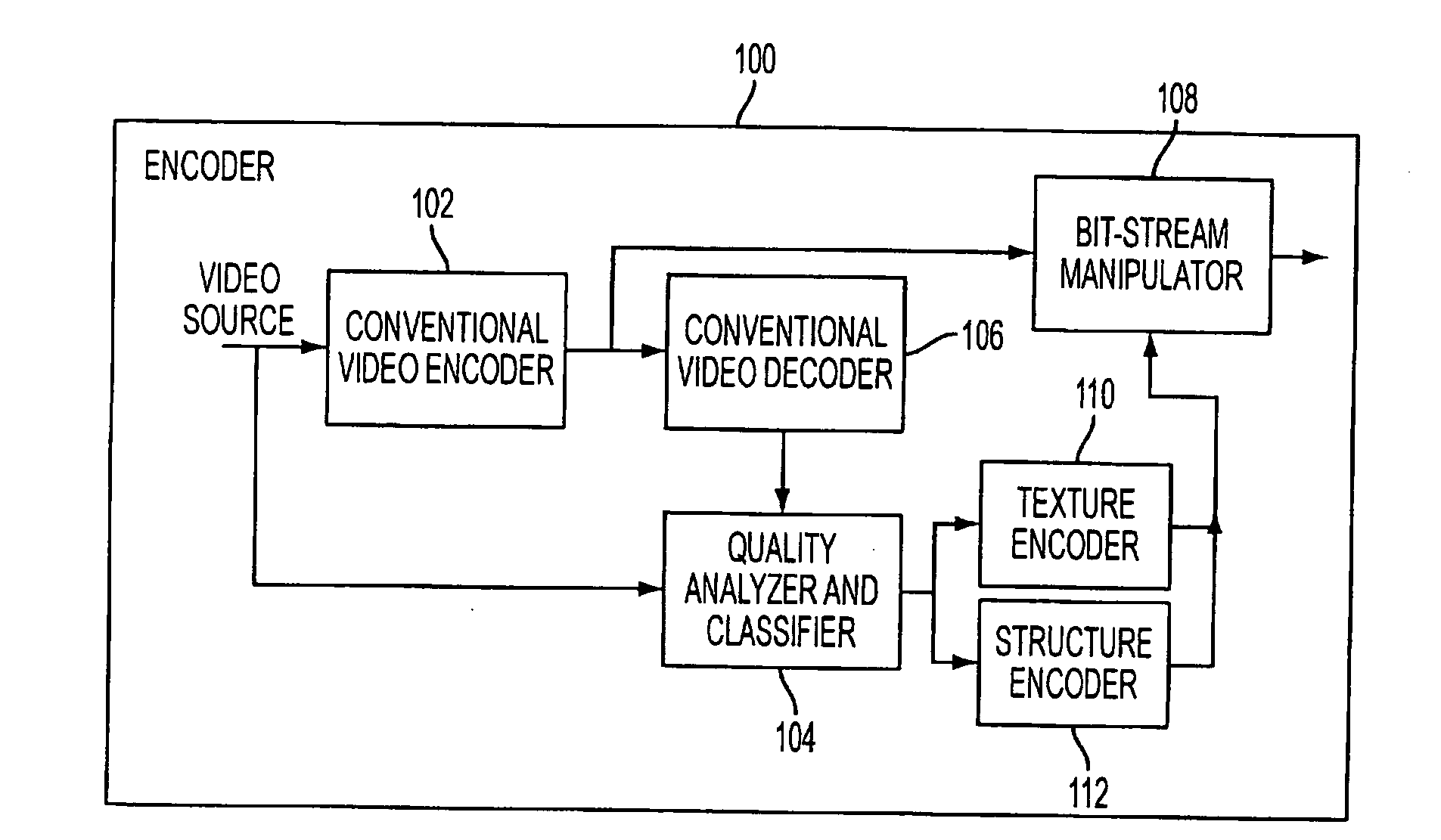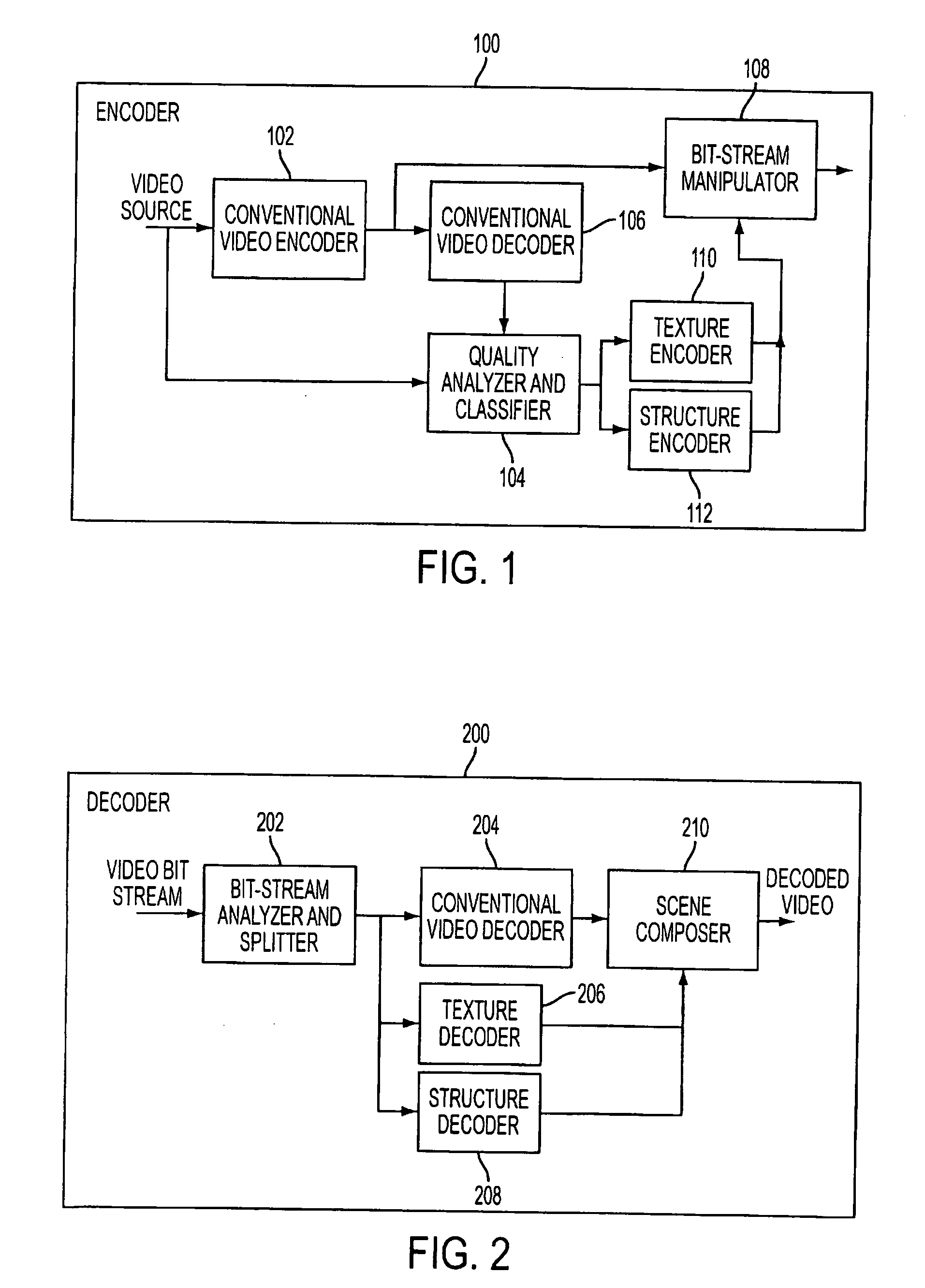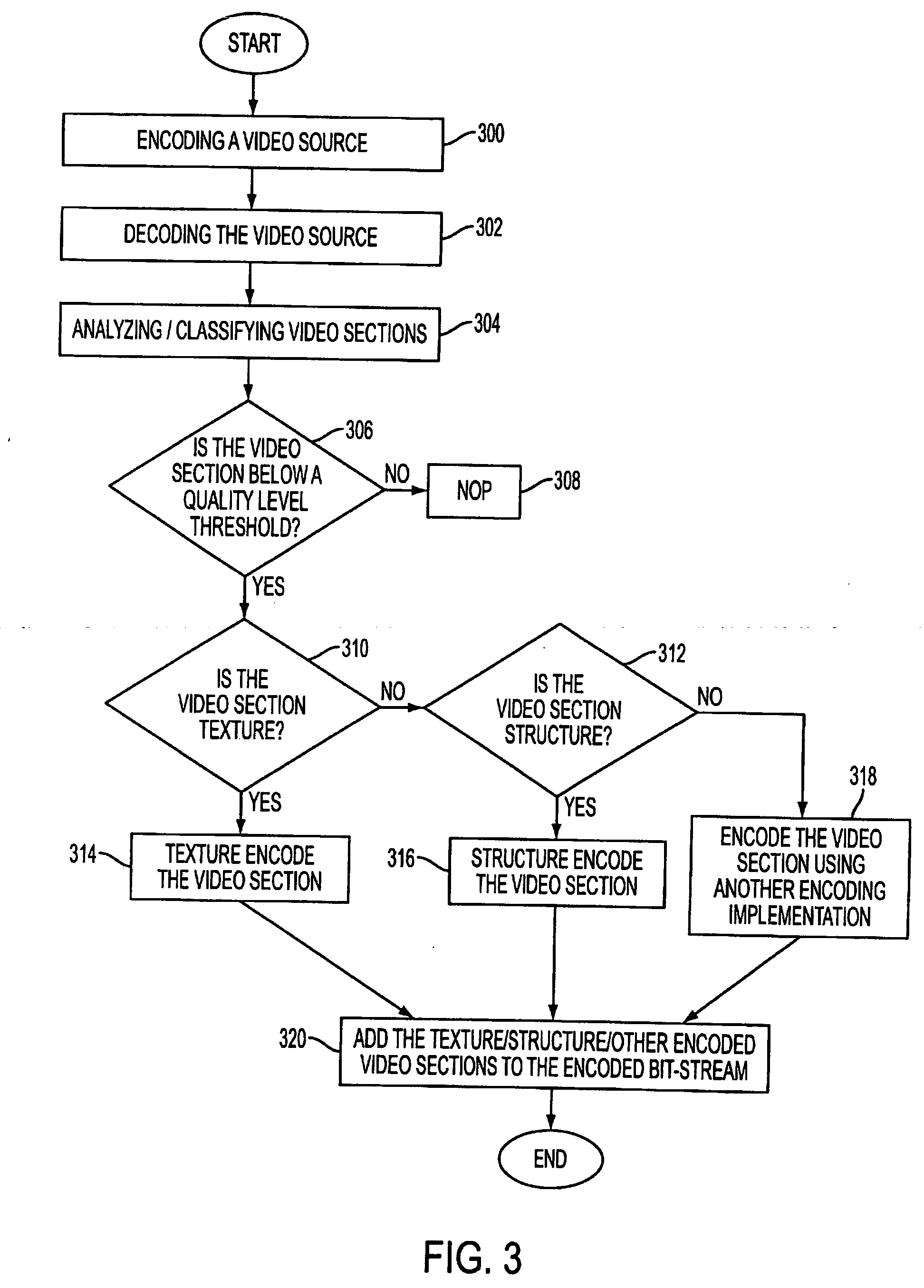[0017]Post multi-modal coding overcomes the shortcomings of video encoders which fail to meet an expected quality standard while encoding some portions of a video. The deficient encoding is typically due to the type of video content or the encoding technique. A method to improve the quality of the deficient portions, identifies macroblocks that are encoded at a deficient quality. Then, the identified macroblocks are encoded with another suitable encoding technique so that the desired quality is met. The improved macroblocks are then inserted into the original bit-stream, replacing the lower quality sections.
[0018]In one aspect, a system for enhancing video encoding implemented on a computing device comprises a plurality of encoders for encoding a video using a plurality of encoding schemes, a quality analyzer and classifier for analyzing and classifying video segments of the video and a bit stream manipulator for forming an encoded video by combining the video segments encoded in the plurality of encoding schemes. The plurality of encoders includes a conventional video encoder, a texture encoder and is a structure encoder. Classifying the video segments is by determining if a difference between a distortion generated by the encoded video and an average distortion of the video is below a threshold. Classifying the video segments is by comparing a variance of each of the video segments and an average variance of a frame and Group of Pictures (GOP) video segments. Analyzing and classifying the video segments of the video occurs automatically. The plurality of video encoders, the quality analyzer and classifier and the bit-stream manipulator are implemented in either hardware, software or a combination thereof. The computing device is selected from the group consisting of a personal computer, a laptop computer, a computer workstation, a server, a mainframe computer, a handheld computer, a personal digital assistant, a cellular / mobile telephone, a smart appliance, a gaming console, a digital camera, a digital camcorder, a camera phone, an iPod®, a video player, a DVD writer / player, a television and a home entertainment system.
[0019]In another aspect, a system for enhancing video encoding implemented on a computing device comprises a first video encoder for encoding video in a first encoding scheme, a video decoder coupled to the first video encoder for decoding the encoded video, a quality analyzer and classifier coupled to the video decoder, the quality analyzer and classifier for analyzing and classifying video segments of the video, a second video encoder coupled to the quality analyzer and classifier, the second video encoder for encoding first selected video segments in a second encoding scheme, a third video encoder coupled to the quality analyzer and classifier, the third video encoder for encoding second selected video segments in a third encoding scheme and a bit-stream manipulator coupled to the first video encoder, the second video encoder and the third video encoder, the bit-stream manipulator for forming an encoded video by combining the video segments encoded in the first encoding scheme, the first selected video segments encoded in the second encoding scheme and the second selected video segments encoded in the third encoding scheme. The first video encoder is a conventional video encoder, the second video encoder is a texture encoder and the third video encoder is a structure encoder. Classifying the video segments is by determining if a difference between a distortion generated by the encoded video and an average distortion of the video is below a threshold. Classifying the video segments is by comparing a variance of each of the video segments and an average variance of a frame and Group of Pictures (GOP) video segments. Each video segment in this scheme is able to include one or more multiple spatial and / or temporal macroblock. In the simplest case, each video segment includes only one macroblock and therefore the comparison between different coding schemes is performed at the macroblock level, one macroblock at a time. The first selected video segments are stored in a first library and the second selected video segments are stored in a second library. The video segments are able to be selected to be as small as a single macroblock. Analyzing and classifying the video segments of the video occurs automatically. The first video encoder, the video decoder, the quality analyzer and classifier, the second video encoder, the third video encoder and the bit-stream manipulator are implemented in either hardware, software or a combination thereof. The computing device is selected from the group consisting of a personal computer, a laptop computer, a computer workstation, a server, a mainframe computer, a handheld computer, a personal digital assistant, a cellular / mobile telephone, a smart appliance, a gaming console, a digital camera, a digital camcorder, a camera phone, an iPod®, a video player, a DVD writer / player, a television and a home entertainment system.
[0020]In another aspect, a method of enhancing video encoding implemented on a computing device comprises encoding a video comprising video segments using a first encoder, decoding the video using a decoder, classifying the video segments as a first quality and a second quality, classifying the video segments of the second quality as a first type and a second type, encoding the video segments of the first type using a second encoder, encoding the video segments of the second type using a third encoder and replacing the video segments of the second quality with the video segments of the first type and the video segments of the second type to form an encoded video. The first quality is high quality and the second quality is low quality. Classifying the video segments as the first quality and the second quality is by determining if a difference between a distortion generated by an encoded video and an average distortion of the video is below a threshold. The first encoder is a conventional video encoder, the second encoder is a texture encoder and the third encoder is a structure encoder. Classifying the video segments of the second quality as the first type and the second type is by comparing a variance of each of the video segments and an average variance of a frame and Group of Pictures (GOP) video segments. The video segments of the first type are stored in a first library and the video segments of the second type are stored in a second library. The video segments are able to be selected to be as small as a single macroblock. Classifying the video segments as the first quality and the second quality and classifying the video segments of the second quality as the first type and the second type occur automatically. The computing device is selected from the group consisting of a personal computer, a laptop computer, a computer workstation, a server, a mainframe computer, a handheld computer, a personal digital assistant, a cellular / mobile telephone, a smart appliance, a gaming console, a digital camera, a digital camcorder, a camera phone, an iPod®, a video player, a DVD writer / player, a television and a home entertainment system.
[0021]In another aspect, a device comprises an encoder system which comprises a plurality of encoders for encoding a video using a plurality of encoding schemes, a first decoder decoding the video encoded with an encoding scheme of the encoding schemes, a quality analyzer and classifier for analyzing and classifying video segments of the video and a bit stream manipulator for forming an encoded video by combining the video segments encoded in the plurality of encoding schemes and a decoder system operatively coupled to the encoder system, the decoder system comprises a bit-stream analyzer and splitter for analyzing and splitting the encoded video based on the plurality of encoding schemes, a plurality of second decoders for decoding the video segments of the encoded video based on the plurality of encoding schemes and a scene composer for composing a decoded video from the decoded video segments. The plurality of encoders include a conventional video encoder, a texture encoder and a structure encoder. The plurality of second decoders include a conventional video decoder, a texture decoder and a structure decoder. Classifying the video segments is by determining if a difference between a distortion generated by the encoded video and an average distortion of the video is below a threshold. Classifying the video segments is by comparing a variance of each of the video segments and an average variance of a frame and Group of Pictures (GOP) video segments. The video segments are able to be selected to be as small as a single macroblock. Analyzing and classifying the video segments of the video occurs automatically. The encoder system and the decoder system are implemented in software. The encoder system and the decoder system are implemented in hardware. One of the encoder system and the decoder system is implemented in software and one is implemented in hardware. The device is selected from the group consisting of a camera, camcorder and camera phone.
[0022]In another aspect, an application executed on a computing device, the application for enhancing video encoding comprises a first video encoder module for encoding video in a first encoding scheme, a video decoder module operatively coupled to the first video encoder, the video decoder for decoding the encoded video, a quality analyzer and classifier module operatively coupled to the video decoder module, the quality analyzer and classifier module for analyzing and classifying video segments of the video, a second video encoder module operatively coupled to the quality analyzer and classifier module, the second video encoder module for encoding first selected video segments in a second encoding scheme, a third video encoder module operatively coupled to the quality analyzer and classifier module, the third video encoder module for encoding second selected video segments in a third encoding scheme and a bit-stream manipulator module operatively coupled to the first video encoder module, the second video encoder module and the third video encoder module, the bit-stream manipulator module for forming an encoded video by combining the video segments encoded in the first encoding scheme, the first selected video segments encoded in the second encoding scheme and the second selected video segments encoded in the third encoding scheme. The first video encoder module is a conventional video encoder, the second video encoder module is a texture encoder and the third video encoder module is a structure encoder. Classifying the video segments is by determining if a difference between a distortion generated by the encoded video and an average distortion of the video is below a threshold. Classifying the video segments is by comparing a variance of each of the video segments and an average variance of a frame and Group of Pictures (GOP) video segments. The first selected video segments are stored in a first library and the second selected video segments are stored in a second library. The video segments are able to be selected to be as small as a single macroblock. Analyzing and classifying the video segments of the video occurs automatically. The computing device is selected from the group consisting of a personal computer, a laptop computer, a computer workstation, a server, a mainframe computer, a handheld computer, a personal digital assistant, a cellular / mobile telephone, a smart appliance, a gaming console, a digital camera, a digital camcorder, a camera phone, an iPod®, a video player, a DVD writer / player, a television and a home entertainment system.
 Login to View More
Login to View More  Login to View More
Login to View More 


